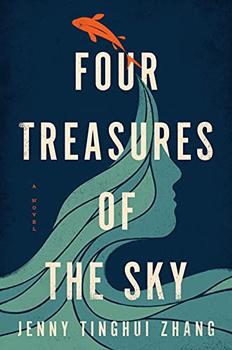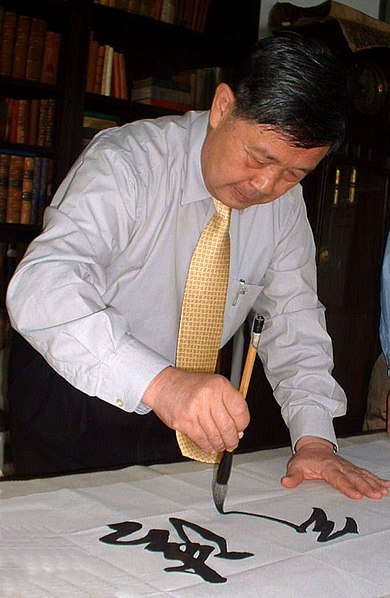Summary | Excerpt | Reviews | Beyond the Book | Read-Alikes | Genres & Themes | Author Bio

A Novel
by Jenny Tinghui ZhangThis article relates to Four Treasures of the Sky
 In Four Treasures of the Sky, heroine Daiyu arrives at Master Wang's calligraphy school as an orphan looking for work. She quickly becomes his best student as she learns about the titular four treasures: brush, ink, paper and ink stone. Since the time of the Northern and Southern Dynasties (420–589 CE), these items have been acknowledged in Chinese calligraphy as the "four treasures of the study." Broadly speaking, calligraphy is defined as an artistic and decorative form of handwriting. Though it would take volumes and volumes of text to trace the entire history of calligraphy in China, we can explore its general progression, and take a closer look at each of the treasures of the study.
In Four Treasures of the Sky, heroine Daiyu arrives at Master Wang's calligraphy school as an orphan looking for work. She quickly becomes his best student as she learns about the titular four treasures: brush, ink, paper and ink stone. Since the time of the Northern and Southern Dynasties (420–589 CE), these items have been acknowledged in Chinese calligraphy as the "four treasures of the study." Broadly speaking, calligraphy is defined as an artistic and decorative form of handwriting. Though it would take volumes and volumes of text to trace the entire history of calligraphy in China, we can explore its general progression, and take a closer look at each of the treasures of the study.
The Chinese written language began to develop over 3,000 years ago, with pictograms and ideographs cut into jade stone or oracle bones, or cast into bronze. During the Han Dynasty (206 BCE–220 CE), ink and paper began to be used to create calligraphy. From early on in the art form's development, a skilled calligrapher was not only seen as a talented writer or artist; good calligraphy was thought to be indicative of a strong moral character — in Four Treasures of the Sky, Master Wang teaches his students philosophy and the importance of conducting oneself well at the same time as he teaches them how to wield the brush. The written character was even thought to resemble the calligrapher physically; a text from the Tang Dynasty (618–906 BCE) encourages making each character assume, in the words of art historian Dawn Delbanco, "the identity of a Confucian sage, strong in backbone, but spare in flesh."
The calligrapher is connected to the characters they write through the first implement: the brush. The most important element of the brush is the tip, which can be made of many different kinds of hair: deer, goat, sable and rabbit are some of the types suggested by the Smithsonian National Museum of Asian Art. In Four Treasures of the Sky, Master Wang says that the greatest honor a calligrapher could bequeath another is to make a brush from their newborn child's hair, guaranteeing that the child will always be connected to the art. The tactile nature of the brush has an importance that is difficult to overstate; as Delbanco puts it, "The brush becomes an extension of the writer's arm, indeed, his entire body."
Brushes, of course, are unable to create calligraphy without the next two treasures — ink and ink stone. Liquid ink for the brush is made by grinding and compressing carbon-based ink onto the solid stone, and adding water. The stone then serves as a dipping pot for the brush. The ink itself is traditionally made from lampblack, a residue created by burning pine resin or oil. The dark pigment can be molded into sticks or cakes and wetted whenever a calligrapher is ready to begin their work. This can have the advantage of making the ink easier to transport than a material that is always liquid, and also allows the individual calligrapher to control the viscosity of the ink. However, calligraphy today is often done with ink that is stored as a liquid.
Finally, the surface for calligraphy is equally important. Before paper became widely available, calligraphers also used wood, bamboo or silk (from circa 300 BCE onward). Early forms of paper were made from combinations of mulberry, hemp and bamboo — not rice, as the Orientalist term "rice paper" suggests. The paper has to be strong and flexible to stand up to different thicknesses of ink and different amounts of pressure applied by calligraphers.
Calligraphy is a form of Chinese art, scholarship and tradition. It blends utility and beauty, and its deep, long-lasting history ties modern calligraphers directly to the artists who came before them. The elevation of calligraphy as visual art in China demonstrates the importance of language in Chinese culture, and makes the art form a perfect occupation for the word-obsessed Daiyu in Four Treasures of the Sky.
Calligraphy of the Chinese calligrapher Sun Xinde. Photo by Immanuel Giel (CC BY-SA 3.0)
Filed under Music and the Arts
![]() This article relates to Four Treasures of the Sky.
It first ran in the May 4, 2022
issue of BookBrowse Recommends.
This article relates to Four Treasures of the Sky.
It first ran in the May 4, 2022
issue of BookBrowse Recommends.






Your guide toexceptional books
BookBrowse seeks out and recommends the best in contemporary fiction and nonfiction—books that not only engage and entertain but also deepen our understanding of ourselves and the world around us.